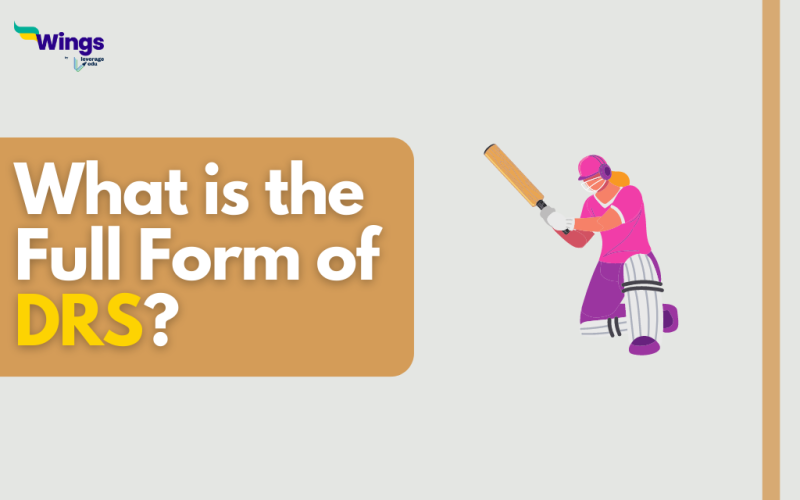The full form of DRS is the Decision Review System. It is a technology-based system used to review and overturn umpiring decisions on the cricket field. DRS was introduced to reduce the number of incorrect decisions in cricket and provide teams with a fair chance to challenge those decisions. It offers four components and offers a plethora of advantages to the world of cricket. Let’s learn about them.
Also Read: What is the full form of ICC?
History of DRS
Now that we know about the full form of DRS, let’s learn a bit about its history. The Decision Review System was first introduced in international cricket in 2008 on a trial basis and officially adopted by the ICC in 2009. It made its debut in the Cricket World Cup in 2011. Over the years, the DRS system has evolved, incorporating technologies like Hot Spot, ball-tracking, and UltraEdge to enhance decision-making accuracy. The concept of “Umpire’s Call” for LBW decisions was introduced in 2014, and the rules regarding retained reviews were adjusted in 2016. The DRS has become an integral part of the game, helping teams challenge umpiring decisions and strive for fairer outcomes.
Also Read: What is the Full Form of RSA in Cricket?
Components of DRS
DRS or the Decision Review System consists of the following components:
- Ball tracking technology: It uses multiple cameras to track the route of the ball starting from the bowler’s hand to the point of contact with the batsman.
- Hot spot: Hot spot technology uses infrared cameras to detect temperature variations on the bat or the pad.
- Snickometer: Snickometer, also known as Ultra Edge, uses sound sensors to detect small sounds when the ball touches the bat or pad.
- Hawk-eye: It is a ball-tracking system that helps umpires predict the trajectory of the ball and its potential impact on the stumps.
Also Read: What is the Full Form of SOR?
How does DRK Work?
When either of the two teams decides to review an umpire decision, they signal the third umpire who has access to the entire DRS system and technology. The third umpire uses the available footage and features of the DRS system to make a more precise decision. If the third umpire finds evidence contrary to the on-field decision, it is changed.
Rules of DRS
Here’s how the DRS system typically works:
- A specific number of reviews per inning is allocated to each cricket. Usually, they are given two unsuccessful reviews for Test matches and one for limited-overs matches.
- When a cricketer or captain disagrees with an on-field decision made by the umpire, they can request a review. This usually happens when they believe a batsman is not out (LBW or caught behind), a catch has been taken cleanly, or if the decision involves a stumping or run-out.
- Thereafter, the decision is referred to the third umpire. He/she has access to various technology tools, including ball-tracking, Hot Spot (infrared imaging to detect contact between the ball and bat), and Snickometer (audio detection of edges).
- The third umpire reviews the footage and makes a decision based on the evidence provided by the technology. They communicate their decision to the on-field umpire via a wireless communication system.
- Then, the team retains the review if the review is successful and the on-field decision is overturned. However, if the review is unsuccessful, and the on-field decision stands, the team loses their review for that innings.
Must Read: What is the Full Form of RR?
Uses of DRS
The DRS uses a variety of technologies, including ball-tracking, hot spot, and Snickometer, to help umpires make more accurate decisions.
- Ball-tracking uses cameras to track the path of the ball and determine whether it would have hit the stumps.
- Hot spot uses thermal imaging to detect the heat generated when the ball makes contact with the bat or pad. Snickometers use microphones to detect the sound of the ball hitting the bat or pad.
- Each team is allowed two Player Reviews per inning. If a review is successful, the original decision is overturned. If a review is unsuccessful, the team loses one of its reviews.
Also Read – What is the Full Form of DLS in Cricket?
Benefits of DRS
The DRS has been controversial since its introduction, with some people arguing that it takes away from the human element of the game. However, it has also been credited with improving the accuracy of decisions and making the game more fair.
Here are some of the benefits of the DRS:
- It helps to reduce the number of incorrect decisions made by umpires.
- It gives teams a way to challenge decisions that they feel are incorrect.
- It makes the game more fair for both batsmen and bowlers.
- It speeds up the game by reducing the number of appeals.
Future of DRS
All the cricket-playing nations are increasingly loving this technology which is why the future of Decision Review Systems is going to scale. Moreover, with the right changes in the technology of DRS, we can expect it to make much better decisions and a higher level of transparency.
Popular Full Forms
We hope this blog has helped you understand the DRS full form and everything related to it. If you want to know more, find the 300+ general full forms list on our blog. In the world of short forms, you can rely on the Leverage edu page to know about more important full forms like this! Connect with us study abroad experts to achieve your international dream today!
 One app for all your study abroad needs
One app for all your study abroad needs













